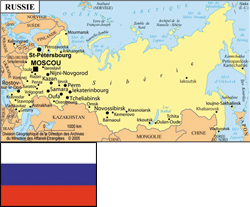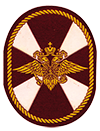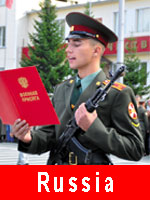
Rosguard
|
1817 Ministry of attachment: Direct subordination to the presidential administration Workforce: 450,000 by 2018 General manager: Général d’armée Address: Garde Nationale de la Fédération de Russie (ROSGVARDIA) - ul. Krassnokazarmennaya, 9a - 111250 - MOSKVA Tél. : +7 495 361 82 48 Press Service: 101990, Moscou - 12 rue Marosseïka Tél. : +7 495 622 33 29 Email : sitcmo@yandex.ru Website : http://rosgvard.ru/ 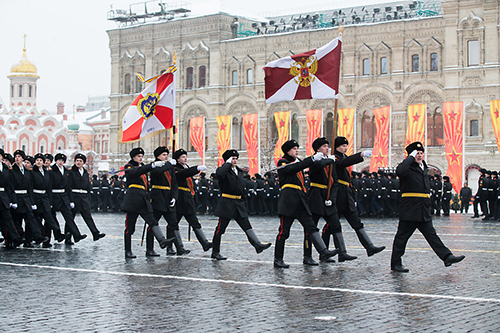
|
History
The Russian Federation National Guard absorbed in 2016 the “Troops of the Inside” or “Troops of Interior” (TI) of the Russian Federation. These were the distant heiresses of the Gendarmerie Special Corps created in 1817 by tsar Alexander 1st in order to supply the police and the Cossacks ‘units. The role of the National Guard is to help the authorities in “The execution of the laws, the court orders, the capture of the criminals”, but also to forbid the gatherings of people, to protect the authorized public demonstrations, to provide prisoners’ escort, the protection of the Treasury, and to rescue in case of fire or in case of floods.
The Gendarmerie Special Corps takes part in the Crimean War (1854-1856). After the revolution of 1917, in order to face the internal security necessities, the troops are repeatedly reorganized under various names (Vohrah, VNUS- ВЧК - OGPU-NKVD), but their objectives remain identical.
New Security Federal structure created on April 5th, 2016 by presidential decree, the Russian Federation National Guard (NG) substituted itself for the former troops of interior (“ViVichniki”). Its restructuring will continue in 2018.
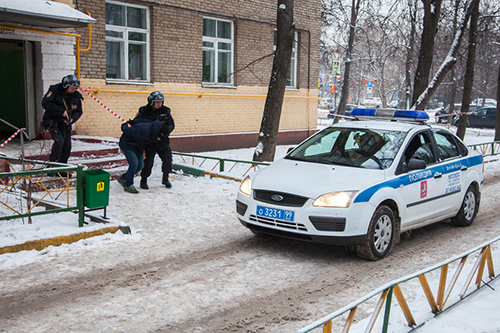
Organization
The National Guard is under the direct subordination of the presidential administration.
Central Organization
• Head office, with the authorized strength of 2100 servicemen.
• Operational Intelligence Branch.
• Special Operations Division (Balachikha).
• Special Operations Centre (Rouss and Vityaz).
• 3 regiments of Forces with specialized vocation.
• 1 regiment of instruction for the Forces with specialized vocation.
• Operational support units.
• Balachikha Camp Support units.
• Balachikha Engineering Support Centre.
Territorial organization
• Moscow - Centre regional Command.
• Saint Petersburg - Northwest regional Command.
• Nijni-Novgorod -Volga regional Command.
• Rostov-on-Don - North Caucasus regional Command.
• Lékatérinbourg - Oural regional Command.
• Novossibirs- Siberia regional Command.
• Khabarovsk - East regional Command.
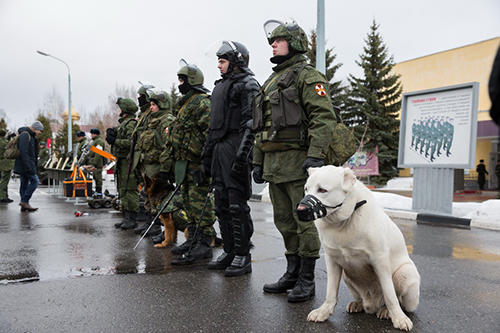
Specialized Training
• Specialized vocation Air support units (central level and in regions).
• Units subordinate to the regional commands of the NG.
• Regions and Republics Specialized Units (OMON, SOBR, OMSN). The OMON of the National Guard (among 160 units for approximately 40.000 men) can mobilize until 1.100 servicemen for each unit, distributed in 5 Spetsnaz battalions and one motorized battalion. They are equipped with armoured vehicles with wheels “T-98 Kombat”, Police specialized Vehicles (SPM) “tiger”, van-pump for maintenance of law and order, armoured vehicles with wheels “BTR”, multi-purpose armoured vehicles “Hummer H2” and bus for maintenance of law and order “Ural” or “Etalon”). The cities of Moscow (Zoubr, Riis, Yastrieb), Saint-Petersburg (Bastion) and Sevastopol ( Berkout) have at their disposal particular OMON regiments.
• Sanitary and Medical support Units and establishments.
Missions
The National Guard took back the traditional missions of the Interior former Troops to which came to be added the fight against the new threats such as terrorism and organized criminality. It performs the following missions:
• maintenance of law and public security order;
• protection of national objectives of vital interest;
• counter-terrorism and fights against the extremism (Out of FSB missions);
• sensitive sites (NUC) and governmental means of communication protection;
• participation in crisis management and in the country operational defence;
• counter-terrorism missions (Out of FSB missions);
• cooperation with the FSB Border Guard in the protection of the Russian Federation borders;
• control of the armament (‘Carrying of weapons’ authorizations delivery) and Private Security societies licences;
• VIP’s protection (Out of FSO missions);
• sensitive sites and Energy substances conveying means protection;
• any mission fixed by presidential decision, in agreement with the Russian Federation Constitution and the laws. As such, intervening for the benefit of the Ministry of Interior (MVD), the Security Federal Service (FSB), the Investigation Committee (SK) or the Prosecution, the National Guard will be now responsible for performing repression missions by use of force of the anti-authority/anti-establishment demonstrations, the dislocation, by any means, for unauthorized demonstrations, the vandals and rioters arrests during demonstrations, the agitators’ neutralization, and the securing of zone.
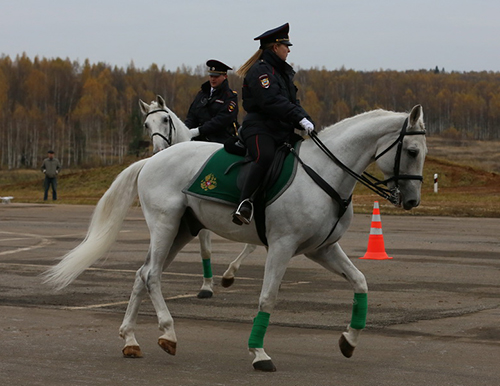
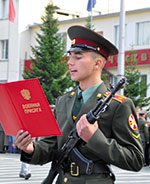 Staff
Staff
In full phase of restructuring, the National Guard has to see all its staffs (especially those stemming from the MVD) coming under military status on the horizon 2018.
Training institutions
4 training establishments:
• Novosibirsk (General Yakovlev) National Guard Military Institute.
• Perm National Guard Military Institute.
• Saint-Petersburg National Guard Military Institute.
• Saratov (Krasnoznamiéni) National Guard Military Institute.
Main equipment
• Armament: pistols: Makarov, Stechkin APS, PS Silent Pistol, SPS, PB and MP-443 Grach - Special armament: APS (Submarine assault rifle), SSP-1M (Submarine pistol) - assault rifles: RPK 74 (AK74) - machine guns: Pecheneg, PKMS - rifles: SVD Dragunov, foldable SVD Dragunov, Dragunov SVU, VSS Vintorez, SV98, VSK94, sniper rifle VKS, Accuracy International AWP - submachine guns: PP-2000, PP-90M1, K-919K.
• Vehicles: BTR-70, BTR-70M, BTR-80, BTR-80A, BMP-2, BRDM-2.
• Aerials means: planes: Il-76, Tu-154, Tu-134, An-72, An-26, An-12 - Helicopters: Mi-8, Mi-24, Mi-26.
• Nautical means: river patrol boats/patrollers.
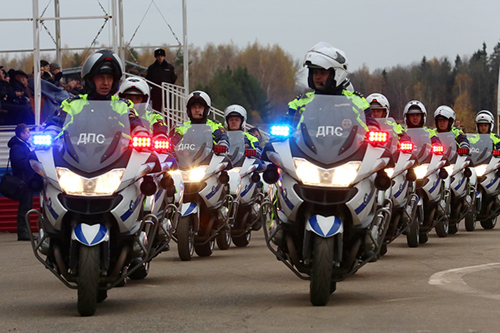
Cooperation
The technical cooperation between the French National Gendarmerie and the Russian ex-troops of interior has known a strong development these last years, leaning on the military status of both structures and closeness of their missions. The actions of cooperation are led, both in Russia and in France, on the following kinds of missions:
• training in mountainous environment in Russia (on 2009 with the GIGN);
• fighting against terrorism (since 2010 with the GIGN);
• democratic management of the crowds (on 2012 with the CNEFG).
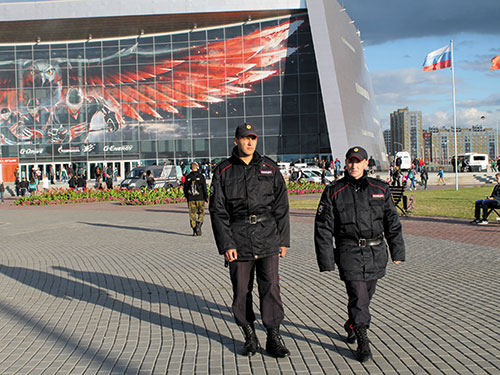
© The iconography was provided by the concerned gendarmeries

